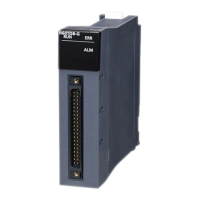96
3 MOTION SFC PROGRAMS
3.3 Branch and Coupling Chart List
Combining the basic type branches/couplings provides the following application types, which are defined as in the basic
types.
Classification Name Motion SFC chart symbol Function
Application type Selective branch
|
Parallel branch
After a selective branch, a parallel branch can be
performed.
Parallel coupling
|
Selective coupling
• The selective coupling point can be the same as the
coupling point of a parallel coupling for selective
branch parallel branch. Note that in the Motion
SFC chart, this type is displayed in order of a
parallel coupling a selective coupling, as shown
on the left.
• In this case, a pointer (Pn) cannot be set between
the parallel coupling point (PAEm) and the selective
coupling point (IFEm).
Parallel branch
|
Selective branch
After a parallel branch, a selective branch can be
performed.
Selective coupling
|
Parallel coupling
• The parallel coupling point can be the same as the
coupling point of a selective coupling for parallel
branch selective branch. Note that in the Motion
SFC chart, this type is displayed in order of a
selective coupling a parallel coupling, as shown
on the left.
• In this case, a pointer (Pn) cannot be set between
the selective coupling point (IFEm) and the parallel
coupling point (PAEm).
Selective branch
|
Selective branch
After a selective branch, a selective branch can be
performed.
Selective coupling
|
Selective coupling
• The two selective coupling points for selective
branch selective branch can be the same. Note
that in the Motion SFC chart, this type is displayed
in order of a selective coupling a selective
coupling, as shown on the left.
• In this case, a pointer (Pn) cannot be set between
the selective coupling point (IFEm+1) and the
selective coupling point (IFEm).
Parallel branch
|
Parallel branch
• After a parallel branch, a parallel branch can be
performed.
• A parallel branch can be nested up to four levels.
IFBm
PABm
PAT1 PAT2
IFT2IFT1
PAEm
IFEm
IFBm
PABm
PAT1
IFT1 IFT2
PAT2
IFBm
IFBm+1
IFT2IFT1
IFT1 IFT2
IFEm+1
IFEm
PABm+1
PABm
PAT1
PAT1 PAT2
PAT2

